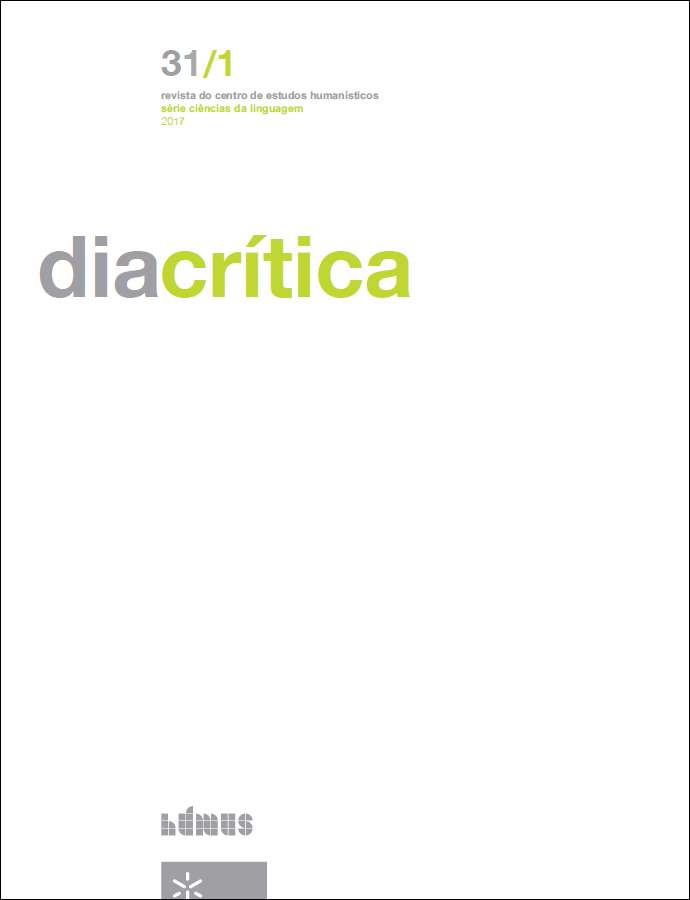O estabelecimento de relações de causalidade sob a perspetiva da sociolinguística variacionista
DOI:
https://doi.org/10.21814/diacritica.4923Palavras-chave:
sociolinguística, relações de causalidade, variáveis sociaisResumo
O presente trabalho insere-se no domínio da variação sintática e tem como objetivo promover a discussão em torno da importância das variáveis sociais na interpretação dos dados linguísticos. Partindo do pressuposto de que a mesma relação semântica pode ser estabelecida através de diferentes estruturas sintáticas, são analisados os mecanismos de conexão frásica que permitem o estabelecimento da relação de causalidade. Seguindo as propostas de Schiffrin (1987), Sweetser (1990), Paiva e Braga (2010), propõe-se a tripartição da noção de causalidade em: causa real, causa explicativa, e causa interacional. Esta divisão é motivada por três fatores: tipologia de ato de fala envolvido (assertivo / não assertivo), tipologia de relação estabelecida (asserida ou pressuposta), e domínio de atuação (domínio do conteúdo, domínio epistémico e domínio ilocutório/interacional).
Os resultados da análise revelam que as relações de causa explicativa são as mais frequentes, independentemente do corpus em análise. Quando observamos os dados para o cruzamento das variáveis sociais, constata-se que a variável grau de escolaridade influencia a ocorrência da relação de causalidade: informantes com mais anos de escolaridade tendem a estabelecer mais frequentemente relações de causa explicativa.
Referências
AGUIAR, J., & Barbosa, P. (2016). Establishing causal relations in European Portuguese: coordination and subordination in a stratified corpus. In F. Pratas, .S. Pereira & C. Pinto. (Eds.), Coordination/Subordination. Form and Meaning—Selected Papers from CSI (pp. 1-22). Newcastle upon Tyne: Cambridge Scholars Publishing.
ALONSO BELMONTE, M. I. (2004). La expresión de la opinión en el discurso escrito: un estudio de la estructura textual de la argumentación en el periodismo de opinión en Inglés. PhD Thesis, Facultad de Filología - Universidad Complutense de Madrid.
BLUM-KULKA, S.; House, J.; Kasper, G. (Eds.). (1989). Cross-Cultural Pragmatics: Requests and Apologies. Norwood, NJ: Ablex.
BRAGA, M. L. (2001). Processos de combinação de orações: enfoques funcionalistas e gramaticalização. SCRIPTA 5 (9), 23-34.
CHESHIRE, J. (1982). Linguistic variation and social function. In S. Romaine, (Org.) Sociolinguistic variation in speech communities (pp. 153-166). London: Edward Arnold.
CHESHIRE, J. (2009). Syntactic variation and beyond. In N. Coupland & A. Jaworski (Orgs.) The New Sociolinguistics Reader. Basingstoke: Palgrave Macmillan, pp. 119-135. CHRISTIE, F. & Derewianka, B. (2008). School Discourse: Learning to Write across the Years of Schooling. London: Continuum. DOI: https://doi.org/10.1007/978-1-349-92299-4_9
CLARIDGE, C., & Walker, T. (2001). Causal clauses in written and speech genres in Early Modern English. ICAME Journal: Computers in English Linguistics 25, 31–63. CoUTINHO, M.A. (2003). Texto(s) e competência textual. Lisboa: Fundação Calouste Gulbenkian.
DIESSEL, H. (2004). The acquisition of complex sentences. Cambridge: CUP DOI: https://doi.org/10.1017/CBO9780511486531
GOUVEIA, C. A. M. (2013). Writing development in Basic School Years in Portugal: Report on a Pilot Project. In Ferreura, J. C. V. et al. (Orgs.), A Scholar for all Seasons - Homenagem a João de Almeida Flor (pp. 209-222). Centro de Estudos Anglísticos da Universidade de Lisboa.
HERRING, S., Scheidt, L. A., Bonus, S., Wright, E. (2005). Weblogs as a bridging genre. Information, Technology & People 18(2), 142–171. DOI: https://doi.org/10.1108/09593840510601513
HOPPER, P. J., & Traugott, E. C. (2003). Grammaticalization. 2nd edition, Cambridge. Labov, W. (1972). Sociolinguistic patterns. Philadelphia: University of Pennsylvania Press.
LOBO, M. (2003). Aspectos da Sintaxe das Orações Subordinadas Adverbiais, Dissertação de Doutoramento, Lisboa, Universidade Nova de Lisboa.
LOBO, M. (2013). Subordinação adverbial. In E. B. P. Raposo, M. F. B. Nascimento, M. A. C. Mota, L. Segura, A. Mendes (Orgs.), Gramática do Português, volume II (pp. 1981-2060). Lisboa: Fundação Calouste Gulbenkian.
LOPES, A. C. M. (2005). Texto e Coerência. Revista Portuguesa de Humanidades 9 (1/2), pp. 13-33. DOI: https://doi.org/10.1016/S0873-2159(15)30532-8
LOPES, A. C. M. (2009). Justification: a coherence relation. Pragmatics, 19 (2), 223-239. LoPES, A. C. M. (2012). Contributos para uma análise semântico-pragmática das causais de enunciação no português europeu contemporâneo. Alfa 56 (2), 451 - 468. DOI: https://doi.org/10.1590/S1981-57942012000200005
LOPES, H. C. (2004) Aspectos Sintácticos, Semânticos e Pragmáticos das Construções Causais. Contributo para uma ReÀexão sobre o Ensino da Gramática, Dissertação de Doutoramento, Porto: Faculdade de Letras da Universidade do Porto.
NEVES, M. H. M. (2000). Gramática de usos do português. São Paulo: UNESP.
NOORDMAN, L. G. M., & Blijzer, F. (2000). On the processing of causal relations. In E. Couper-Kuhlen & B. Kortmann (Eds.) Cause, Condition, Concession and Contrast. Cognitive and Discourse Perspectives (pp. 35-56). New York: Mouton de Gruyter PaIva, M. C. A., & Braga, M. L. (2010). Cláusulas causais introduzidas por porque: da sintaxe ao discurso. In: M. C. Mollica (Org.). Usos da linguagem e sua relação com a mente humana (pp. 55-71). Rio de Janeiro: Editora Tempo Brasileiro. DOI: https://doi.org/10.1515/9783110219043.1.35
PAIVA, M. C. A., Braga, M. L. (2006). Conjunções lexicais e gramaticais: o caso de por causa de. Gragoatá (UFF), v. 21, p. 57-84.
PERES, J. A., & Mascarenhas, S. (2006). Notes on sentential connections (predominantly) in Portuguese. Journal of Portuguese Linguistics 5, 113-169. DOI: https://doi.org/10.5334/jpl.156
SCHIFFRIN, D. (1987). Discourse markers. Cambridge: Cambridge University Press. ScHILLINu-EstES, N. (2002). Investigating stylistic variation. In J. C. Chambers, P. Trudgill, & N.Schilling-Estes (Eds.) Handbook of Language Variation and Change (pp. 375-401). Oxford: Blackwell Publishing.
STUKKER N., & Sanders, T. (2011). Subjectivity and prototype structure in causal con- nectives: A cross-linguistic perspective. Journal of Pragmatics, 44(2),169-190 SYEETSER, E. (1990). From etimology to pragmatics, Metaphorical and cultural aspects of semantic structure. Cambridge: Cambridge University Press. DOI: https://doi.org/10.1016/j.pragma.2011.06.011
Downloads
Publicado
Como Citar
Edição
Secção
Licença
Direitos de Autor (c) 2023 Joana Aguiar

Este trabalho encontra-se publicado com a Creative Commons Atribuição-NãoComercial 4.0.










